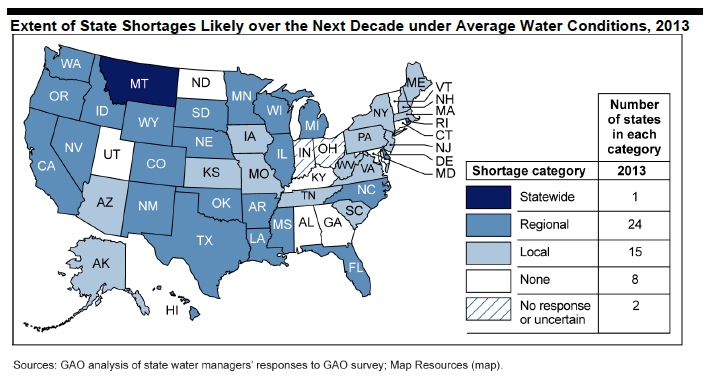GOVERNMENT ACCOUNTABILITY OFFICE
Why GAO Did This Study
The nation’s water bodies have long supplied Americans with abundant freshwater, but recent events, such as the ongoing California drought, have focused attention on competing demands for this limited resource. In the United States, the states are primarily responsible for managing freshwater resources, and many federal agencies influence states’ management decisions. In 2003, GAO issued a report providing an overview of trends in freshwater availability and use, as well as states’ views on ways the federal government could assist states to help meet future water management challenges.
GAO was asked to report on changes since 2003. This report examines (1) issues related to freshwater availability and use; (2) expectations for water availability and use over the next 10 years and how these expectations may affect water planning; (3) steps, if any, states have taken to manage freshwater resources; and (4) actions, if any, federal agencies have taken to support management of freshwater availability and use and perspectives from state water managers, experts, and literature on what the federal government can do to enhance its support. GAO conducted a survey of 50 state water managers with a response rate of 100 percent. GAO also reviewed reports and documents from entities, such as federal agencies and environmental organizations, and interviewed federal officials and experts, including environmental and industry officials, to understand freshwater issues across the nation.
GAO is not making recommendations.
What GAO Found
Key issues related to freshwater availability and use—such as concerns about population growth straining water supplies, lack of information on water availability and use, and trends in types of water use—remain largely unchanged since 2003, according to state water managers, experts, and literature. In addition, GAO’s review found certain issues, such as the impacts of climate change and extreme weather events, including droughts and floods, on water resources and the effect of the energy sector on water quantity and quality, have gained prominence.
According to state water managers, experts, and literature GAO reviewed, freshwater shortages are expected to continue into the future. In particular, 40 of 50 state water managers expected shortages in some portion of their states under average conditions in the next 10 years (see fig.). However, uncertainty stemming from factors, such as patterns of economic growth and land use change, is likely to complicate future state water managers’ planning efforts.
GAO’s review found that over the last decade states have taken a number of steps to improve management of freshwater availability and use. These include conducting freshwater resource studies and assessments, developing drought preparedness plans, developing water management tools, taking conservation actions, and taking steps to address climate change impacts on water resources.
Since 2003, federal agencies have taken various actions to support freshwater management. For example, the Department of the Interior’s U.S. Geological Survey initiated the National Water Census to assess water availability and use across the nation. Also, numerous agencies participate in the National Drought Resilience Partnership, created in 2013. In addition, state water managers, experts, and literature GAO reviewed identified actions the federal government could take to support state water management efforts, including increased collaboration among federal agencies and with states and other stakeholders, and maintaining and collecting key data.
Download full version (PDF): Freshwater
About the Government Accountability Office
gao.gov
The U.S. Government Accountability Office (GAO) is an independent, nonpartisan agency that works for Congress. Often called the “congressional watchdog,” GAO investigates how the federal government spends taxpayer dollars.
Tags: drought, Freshwater, GAO, Government Accountability Office, Water Supply







 RSS Feed
RSS Feed